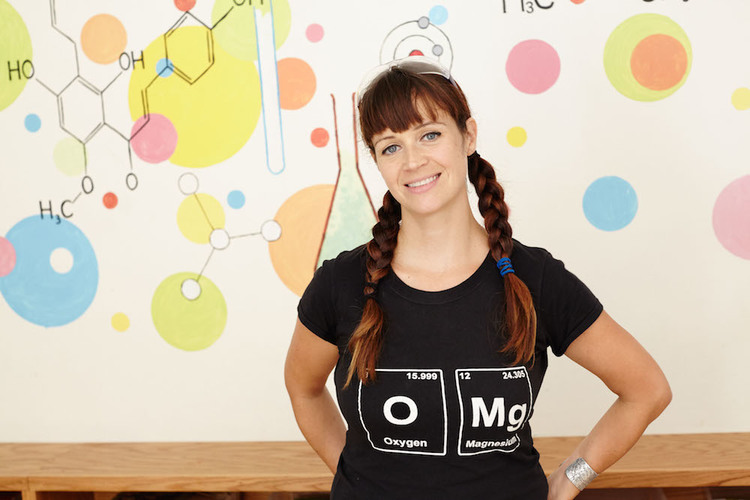By Lela Nargi
For the past several years, kids have been STEMed up the wazoo as the national conversation about education—and more particularly, what’s wrong with it—has centered on a perceived lacking in Science, Technology, Engineering, and Math. Also lacking in the face of much high-minded assessment? A sense of fun, and of the integral, integrated way that science flows through our lives and the lives of our children, (yes, even city children), if we just know how to pay attention.
Enter Julie G. and her uncluttered outpost hunkered on a bright corner of Brooklyn’s Windsor Terrace, Tiny Scientist. Here, for the last two years, the former metal singer turned elementary science teacher shows area kids what’s fun and oh-so-relevant about science in the city. She’s uniquely suited to the task: “I was never interested in science in school,” she confesses. “We had a third grade teacher, ‘Mean’ MacLean, who was actually mean and didn’t teach us anything.” As a result, she initially shirked college until, enrolled in her 20s in an adult learners program at City College, she found herself taking a basic science course. “The teacher showed us slides of cells multiplying and I was immediately hooked,” says Julie, who went on to get masters in biology, math, and science elementary education at Hunter College.
After 10 years teaching science to public school kids, and having just become a first-time mom herself, to daughter, Quinn (Julie’s husband, Andrew Schneider, is a sound engineer for Blue Man Group), she took the plunge and opened her own little science oasis. We caught up with her to get her take on what’s so fun, and what’s so relevant for city kids, about all kinds of science.
Rocks: In the Tiny Scientist class “Rock Cycle Riot,” geared towards kids aged 5 to 10, children put on their paleontology hats to study the Jurassic period and recreate an excavation. Says Julie, “We use lots of visual references and discuss how all rocks started as one type of rock, and changed into other types of rocks over millions of years with pressure. In a class like this, there’s also measuring, sequential thinking, history, sensory development and literacy, because we read books about it.”
But what do prehistoric times have to do with the science we see in the world around us today? “One of the big things we learn is that things change over time,” says Julie. “That’s a big skill for kids, to be able to observe things that happen in some sort of sequence. One of the ways that kind of thinking is applicable to any environment, but particularly the city, where people think we don’t see any nature, is with leaves changing with the seasons. But there are so many ways it works for kids. Kids living in the ‘concrete jungle’ see buildings being built up from big holes in the ground. And they can experience how forceful and important nature is by taking a closer look at the ground right beneath their feet. Very few living things can break rocks, but trees can! And especially here in Brooklyn, we see the sidewalks breaking from the tree roots growing out of them.”
Candy: Working with treats isn’t just about satisfying your sweet tooth. In fact, for kids as young as 4 who are enrolled in Tiny Scientist’s “Candy Chemistry” class, there’s almost no sugar-eating at all. Even though Julie does show kids how to add agar agar to sugar syrup to make gummy candy, “Actually,” she says, “it’s just a fun anchor for studying real science concepts, like pressure, which we use to smash things like marshmallows.”

Air pressure, she points out, is literally everywhere, even though we can’t see it. Standing on a subway platform, almost every kid in New York has felt air pushing through the tunnel as the train has neared the station. But even a task as mundane as blowing bubbles on the sidewalk is loaded with useful information for kids who are learning to observe closely. “Bubbles can tell you about the wind, how fast it’s moving, the direction it’s coming from, how air moves around corners,” says Julie. “Learning about this is training kids to think about what doesn’t seem to be there but is actually all around you.”

Making: Julie’s class “Maker Magic” is a kind of free-for-all of engineering and tech concepts, where kids in grades 2 through 5 make things like lava lamps and put together working circuits. These are building blocks for all manner of things that shelter us, and keep us comfortable as we live and work and move from place to place. “We just looked at propellers and talked about sustainable energy versus fossil fuels. Then we built solar panel circuits attached to small motors,” says Julie.
How does all this pertain to city living? “There’s a block right here in Windsor Terrace that’s becoming a heavy topic of conversation, because there are locally based organizations trying to get homeowners to put solar panels on the roofs of their houses. A lot of schools are experimenting with using them to power machines, and the panels are becoming more and more a part of city life. Even the Brooklyn Botanic Garden uses them, and some of the bridges have solar lights.” And possibly the best part of all for parents hoping to help their kids become keen observers, even after their class at Tiny Scientist has draw to a close: “Trips to see these things cost nothing!” says Julie.
Photographs by Roy Beeson.



